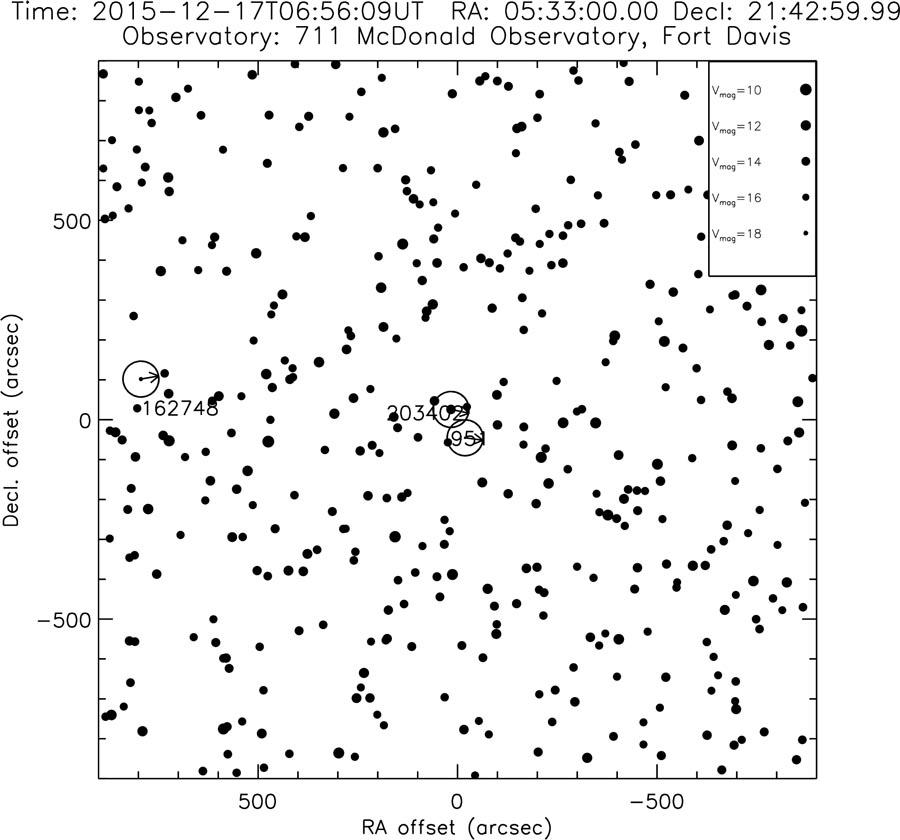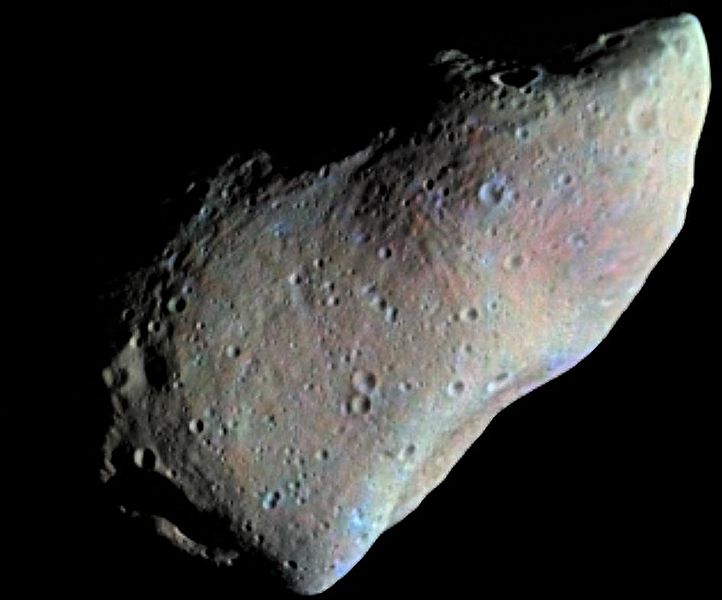
 | SOCO Blog |
09 January 2016
ASTEROID 951 GASPRA
In my previous blog entry of 24 October 2015, I described imaging a "mystery object" that turned out to be an asteroid, 1529 Oterma. Of course, our solar system contains millions of asteroids, so it's not unlikely that the brighter ones may make an appearance from time to time in our imagery. This is certainly the case because, when processing the imagery acquired of the Crab Nebula (M 1) on 16 December 2015, the tell-tale trace of another asteroid showed up. As shown in Figure 1, the track shows the movement of the asteroid from left to right in the image over a period of around 3 hours.

Figure 1. The track of the asteroid (circled in yellow) to the south-west of the Crab Nebula (M 1) in Taurus.
Originally, I was pretty much going to ignore this one. I mean, one track on a star field looks pretty much like the next, so there's no point showing you a picture each time one of these things gets imaged. But, on a night that I didn't have anything special to do, I though I'd at least check and see if I could identify which one this was. As I described in the previous blog entry, the best way to do this is to go to the Lowell Observatory webpage and use their online application for identifying minor planets (asteroids). It will plot a finder map of the known asteroids in a given portion of the sky. You just have to provide the location (RA and Declination), the date, and the time. Figure 2 shows the finder map produced from the information I provided.

Figure 2. Lowell Observatory finder map for the portion of the sky containing the observed asteroid.
Source: Lowell Observatory.
As Figure 2 shows, there were two asteroids roughly at the location indicated in Figure 1. One (called 203402 2001 XE167) had a visual magnitude of 19.2. The other was quite a bit brighter, at magnitude 13.1— this is the one showing up in my image. A subsequent search in the raw imagery using the blink technique (where two images taken at different times are alternately displayed— any object that is moving will appear to blink from one point in the first image to another point in the second image) did not show a second moving object in that area, so 203402 2001 XE167 was apparently too dim to be caught by my imagery that night.
The brighter asteroid showing up in my imagery is called 951 Gaspra. When I saw the name in the tabular data also produced by the Lowell Observatory application, I thought "This name sounds familiar." So I checked Wikipedia and, sure enough, this turns out to be a very famous piece of space-rock. Gaspra was the first asteroid to be studied by a spacecraft. On 29 October 1991, the Galileo spacecraft (on its way to Jupiter) passed within 5300 km of Gaspra and took 57 images of it. This is the first time in history that we got to see what an asteroid really looks like up-close. A color composite image aquired near closest approach is presented in Figure 3. This image has a surface resolution of approximately 54 meters/pixel, and shows numerous small craters scattered over the surface of the object.

Figure 3. The asteroid 951 Gaspra as imaged on 29 October 1991 by the Galileo spacecraft.
Source: USGS/NASA/JPL.
951 Gaspra was discovered by the Russian astronomer G. N. Neujmin in 1916, who named it after the town of Gaspra on the coast of the Black Sea. The asteroid has an elongated shape (18.2 × 10.5 × 8.9 km) with a mean radius of 6.1 km. This puts it in the same size range as the moons of Mars, Deimos and Phobos, which are thought to be captured asteroids. It orbits very close to the inner edge of the asteroid belt at an average distance of 2.2 Astronomical Units (3.3 × 108 km) from the Sun. It takes Gaspra 3.28 years to make one trip around the Sun.
I feel kind of privileged to have been able to see (albeit from a very great distance) such a famous object. It's kind of neat to compare Figure 1 and Figure 3 and think, "That's what that little point of light in my image really looks like." And to think that it was imaged by the Galileo spacecraft back in 1991— man, that seems a long time ago! Hopefully I'll have the chance to catch it a few more times in my lifetime.
|
 Return to SOCO Blog Page
Return to SOCO Blog Page
 Return to SOCO Main Page
Return to SOCO Main Page
Questions or comments? Email SOCO@cat-star.org